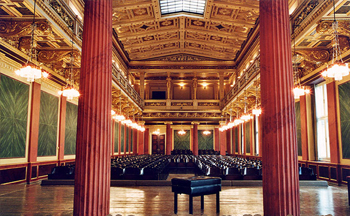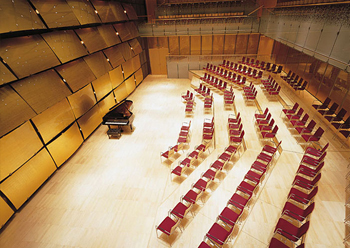Tonhalle Orchestra Zurich
November 2025 | ||||||
|---|---|---|---|---|---|---|
Mo | Tu | We | Th | Fr | Sa | Su |
The Tonhalle Orchestra Zurich is one of Switzerland's leading symphony orchestras, renowned for its exceptional musicianship and artistic excellence. Founded in 1868, the orchestra has played a key role in Zurich's cultural life and has gained international recognition. Under the direction of esteemed conductors such as David Zinman and Paavo Järvi, the ensemble has developed a distinctive sound, combining tradition with innovation.
The orchestra performs at the historic Tonhalle Zurich, a venue known for its outstanding acoustics. Its repertoire spans classical masterworks, contemporary compositions, and exciting collaborations with world-class soloists. The Tonhalle Orchestra Zurich is also dedicated to engaging with new audiences through educational programs, recordings, and international tours.
With a deep commitment to artistic quality and an ever-evolving vision, the Tonhalle Orchestra Zurich continues to inspire music lovers worldwide.
Program and cast
PERFORMERS
Tonhalle-Orchester Zürich
Paavo Järvi, conductor
Sol Gabetta, cello
PROGRAM
ROBERT SCHUMANN
Concerto for Cello and Orchestra in A minor, Op. 129
– Intermission –
GUSTAV MAHLER
Symphony No. 1 in D major
Approximate end: 21:30
22 November 2025
PERFORMERS
Tonhalle Orchestra Zurich
Singverein of the Society of Friends of Music in Vienna
Paavo Järvi, Conductor
Mari Eriksmoen, Soprano
Anna Lucia Richter, Mezzo-soprano
PROGRAM
GUSTAV MAHLER
Symphony No. 2 in C Minor
Ends approx. 9:00 PM
Musikverein Golden Hall
This building is located on Dumbastraße/Bösendorferstraße behind the Hotel Imperial near the Ringstraße boulevard and the Wien River, between Bösendorferstraße and Karlsplatz. However, since Bösendorferstraße is a relatively small street, the building is better known as being between Karlsplatz and Kärntner Ring (part of Ringstraße loop). It was erected as the new concert hall run by the Gesellschaft der Musikfreunde, on a piece of land provided by Emperor Franz Joseph I of Austria in 1863. The plans were designed by Danish architect Theophil Hansen in the Neoclassical style of an ancient Greek temple, including a concert hall as well as a smaller chamber music hall. The building was inaugurated on 6 January, 1870. A major donor was Nikolaus Dumba whose name the Austrian government gave to one of the streets surrounding the Musikverein.
Great Hall - Golden Hall
 “As high as any expectations could be, they would still be exceeded by the first impression of the hall which displays an architectural beauty and a stylish splendour making it the only one of its kind.” This was the reaction of the press to the opening of the new Musikverein building and the first concert in the Großer Musikvereinssaal on 6 January 1870.
“As high as any expectations could be, they would still be exceeded by the first impression of the hall which displays an architectural beauty and a stylish splendour making it the only one of its kind.” This was the reaction of the press to the opening of the new Musikverein building and the first concert in the Großer Musikvereinssaal on 6 January 1870.
The impression must have been overwhelming – so overwhelming that Vienna’s leading critic, Eduard Hanslick, irritatingly brought up the question of whether this Großer Musikvereinssaal “was not too sparkling and magnificent for a concert hall”. “From all sides spring gold and colours.”
Brahms Hall
 "In order not to promise too much it can be said that it has been made into the most beautiful, most magnificent, perfect example of a chamber concert hall that any of us knows in the world.” This was the reaction of a Vienna daily newspaper in October 1993 as the Brahms-Saal was presented to the public after extensive renovation work.
"In order not to promise too much it can be said that it has been made into the most beautiful, most magnificent, perfect example of a chamber concert hall that any of us knows in the world.” This was the reaction of a Vienna daily newspaper in October 1993 as the Brahms-Saal was presented to the public after extensive renovation work.
The surprise was perfect. It was a completely new hall. In contrast to the Grosse Musikvereinssaal, the Brahms-Saal had changed its appearance quite considerably over the years. When and how it acquired that slightly melancholy duskiness that was known to music lovers before 1993 cannot be precisely documented.
Glass Hall
 As a venue for events from concerts to luxury banquets, the Glass Hall / Magna Auditorium is not only the largest of the Musikverein's 4 new halls but also the most flexible in terms of usage.
As a venue for events from concerts to luxury banquets, the Glass Hall / Magna Auditorium is not only the largest of the Musikverein's 4 new halls but also the most flexible in terms of usage.
Hub podiums enable the smooth transformation of the concert hall into a conference centre, the cinema into a ballroom, or the stage into a catwalk. State-of-the-art equipment for sound, lighting, video and widescreen digital projection provide the ideal conditions for half-scenic productions.
The Glass Hall / Magna Auditorium was designed by the Viennese architect Wilhelm Holzbauer. With a height of 8 metres, the hall (including the gallery) can play host to up to 380 visitors.

 EN
EN DE
DE IT
IT FR
FR ES
ES RU
RU JP
JP RO
RO
 Seating plan
Seating plan 

